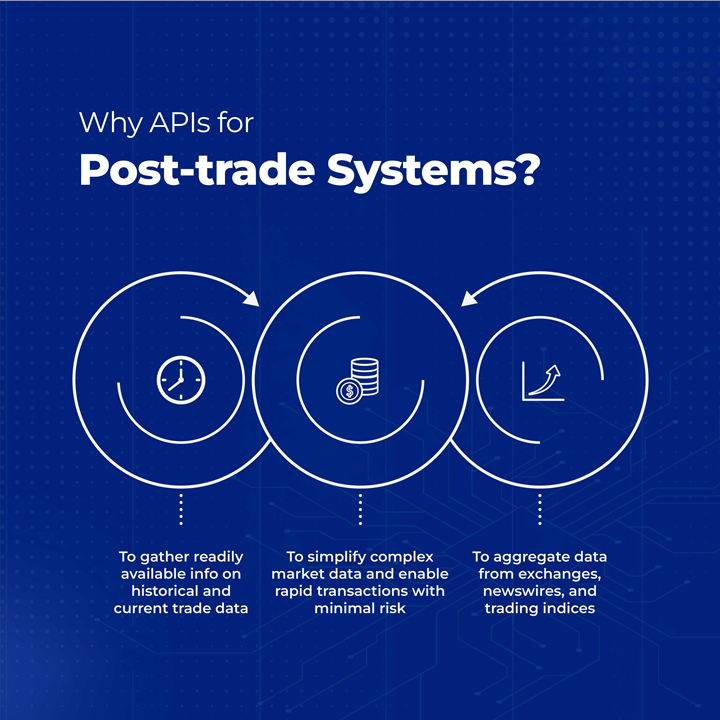For years, post-trade systems have been viewed as fundamental infrastructure for driving trades to completion rather than a domain for continuous technological enhancements.
However, skyrocketing trading volumes, shortened settlement cycles, growing market fragmentation, the introduction of new asset classes, and fast-evolving regulatory demands have revealed the limitations of this traditional perspective.
As a result, modern-day back-office operations have transformed into cost centers riddled with data silos and manual processes. According to Depository Trust & Clearing Corporation (DTCC), post-trade operations cost an estimated US$6-9 billion annually.
In addition to eating into profitability, dependency on legacy post-trade systems can create a variety of bottlenecks that can limit a financial institution’s ability to swiftly adapt to evolving market dynamics.
Legacy Post-Trade System Limitations
Inefficient Trade Processing
Relying heavily on manual trade confirmation and matching, archaic back-office operations delay executions and increase the risk of trade errors. Consequently, this can drive up operational costs and lead to non-compliance with regulatory requirements.
Allocation Limitations
Legacy systems struggle with the intricacies of multi-leg, cross-asset, or multi-currency trade allocations, resulting in operational bottlenecks and sluggish post-trade processes. This can, in turn, introduce risks into the system and leave customers dissatisfied.
Restricted Asset Class Management
Most legacy post-trade systems are designed to handle traditional securities and lack the flexibility to integrate non-standard data formats from emerging exchanges.
The lack of data harmonization and integration limits financial institutions from catering to evolving investor demands and capitalizing on new and innovative financial instruments for their business.
Delayed Trade Settlements
Dependence on manual post-trade processing operations combined with poor data integration, outdated technology stacks, and lack of automation in archaic systems can delay trade settlements. With settlement cycles slated to transition from T+2 to T+1, these delays can prove expensive and expose organizations to operational and financial risks.
Limited Scalability
As trade volumes surge to historic highs, legacy post-trade systems reliant on manual processes are increasingly turning into bottlenecks. With trading volumes estimated to continue growing, financial institutions need modern post-trade systems that can scale to accommodate the demands of the trading industry.
The limitations of antiquated technology coupled with evolving market trends mandate institutions to modernize post-trade systems to survive and thrive. However, the post-trade modernization journey is rife with obstacles and comes at an extensive cost.
Challenges in Post-Trade Modernization
One of the primary reasons most financial institutions shy away from modernizing back-office operations is the complex mesh of antiquated technology powering them. Most post-trade systems comprise years of complex post-trade processing logic encapsulated in fragmented silos.
Over the years, these silos have become obsolete to an extent where it has become easier to leverage manual human intervention over disrupting the underlying system and risking business continuity.
Due to these reasons, organizations have continued to rely on the fundamental processing capabilities of legacy post-trade systems while investing heavily in front- and middle-office technological makeovers.

APIs: A Cost-Effective Gateway to Risk-Free Post-Trade Efficiency
APIs act as a crucial bridge, seamlessly connecting the logic and capabilities of legacy post-trade systems with modern technology. This modernization occurs without the need for a comprehensive technological overhaul of the underlying infrastructure.
By doing so, it helps organizations seamlessly overcome the bottlenecks of antiquated technology.
Ionixx recently helped a leading US-based broker-dealer develop customized APIs to integrate siloed and fragmented data for enhanced visibility and improved decision-making. You can download the complete case study here[link to the case study].
Data Harmonization
APIs enable real-time exchange and harmonization of data between the back-office and external systems such as market feeds, clearinghouses, and regulatory databases.
By streamlining data integration from external sources, APIs enable simplified integration of new asset classes, streamline collateral management, enhance trade processing efficiencies, and improve regulatory compliance.
Workflow Automation
With APIs, financial institutions can seamlessly integrate third-party automation tools to automate manual post-trade workflows eliminating errors and optimizing settlement times. In addition, it enables organizations with the scalability they need to manage increasing trading volumes with speed and accuracy while meeting the changing regulatory requirements.
Real-Time Monitoring
Combining data harmonization and workflow automation, APIs enable real-time monitoring of data feeds from various sources. With access to real-time data on post-trade activities, institutions are empowered to promptly react to market changes and emerging risks.
Incremental Modernization
By building API layers around monolithic post-trade systems financial institutions can create a secure and accessible endpoint for all other systems to connect to it. The process ensures interoperability to allow seamless exchange of data and functionalities between systems and supports the phased transition of legacy processes to the cloud.
It provides a layer of abstraction between the existing system’s functionality and underlying technology to enable risk-free modernization while maintaining business continuity. In addition, the secure connectivity point builds a structure that can be leveraged to integrate new features and facilitate modular updates for scalability and adaptability.

APIs enable financial institutions to integrate new technologies, optimize data, and automate post-trade operations, improving efficiency and cost-effectiveness. They also lay the foundation for a future-proof architecture, all without the need for extensive restructuring of legacy systems, ensuring adaptability and longevity in a dynamic financial landscape.
Robust post-trade and digital brokerage services that are forward-looking and can handle future scaling are the way to go even as brokerages learn to prepare for the impending T+1 accelerated settlement cycles.

